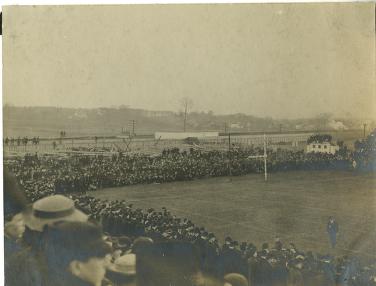Magazine

A Tremendous Load of Humanity
By Emily Swenson
On November 18, 1905, the University of Michigan Wolverines hosted the University of Wisconsin Badgers in one of the most highly anticipated football games of the season. Anywhere between 15,000 to 18,000 fans filled Ferry Field to attend the unofficial homecoming game, shattering previous attendance records. So high was the demand for seats that speculators were selling $3 general admission tickets for as high as $8.50, despite protests from Michigan Athletic Director Charles Baird.

The bleacher collapse was captured on film and published in the Detroit Free Press. BL020774
With a forecast that called for blue skies and mild weather, the two teams took the field at 1:55 p.m. The first half began with a fumbled punt by the Badgers and ended with a 6-0 lead for the Wolverines. Shortly after the second half began, Charles Baird and a patrolman noticed the overcrowding in the west stands and began pleading with fans to evacuate the bleachers. Most paid them no attention, refusing to give up their seats and instead focusing solely on the game. Minutes later, a “tearing, splintering sound” shook the stadium as the west bleachers began collapsing, close to 3,000 spectators falling with them.
The first 10 rows were completely flattened by the “tremendous load of humanity,” and large timbers fell into the crowd, leaving one spectator unconscious. Masses of people were hurled forward, trapped between the fallen bleachers and a wire fence.
Players from both teams rushed to the aid of the fallen, ripping open the fence that separated the spectators from the field. Astonishingly, the shock and destruction caused by the collapse were not enough to end the game. The evacuation of the injured caused a relatively short delay, and a majority of the crowd simply relocated to another area of the field and watched as Michigan went on to win 12-0.
Among the seriously injured that day were Frank W. Scott from Ypsilanti, Vern Huir from Milwaukee, and Joseph Ross, a Michigan undergraduate.
The bleacher collapse spawned years of paperwork for the University. Today, these records provide valuable insight into everything from court settlements to medical care. The Athletic Department papers contain medical bills that were received from Ann Arbor citizens, and doctors who had taken the injured into their homes for emergency medical attention. Baird himself issued a check for $10 to an R. Thomas for “bedding, clothing etc. torn up for bandages to tie up injuries or people, also damage to carpet and house furnishings.”
The Michigan Athletic Association preemptively awarded the injured parties sums of money in exchange for the release from all claims for personal injury. These claims ranged from $12 to $150 and were, for the most part, settled by 1906, with the exception of a case involving a Mr. Arthur Brown. The Brown case lasted until 1910 and resulted in a payment from the University to Brown of $500. Joe Ross, the University of Michigan student with a broken leg, was reimbursed for a $2 ambulance ride and a $15 surgery.
The Michigan Technic, a semi-annual publication from the Engineering Society, published the “Official Report of Grandstand Collapse” in 1908. The report, which was commissioned by the Dean of the Engineering Department, suggests that a combination of overcrowding and the poor structural integrity of a portion of the bleachers caused the collapse. At the time, however, the accident was blamed chiefly on overcrowding and the wild cheering and stomping of fans. News outlets and University publications alike spoke of the “immense crowd and inadequate provision,” fueling an ongoing debate regarding large crowds and general admission games.
A new stadium and an expansion of Ferry Field had been in the works for a few years, but this accident made the need for more seating and safer accommodations even more urgent. The Michigan Alumnus called for a stadium like those in “the East,” one that was “more solidly built, and if possible of more substantial material.”
The next year, the Michigan Wolverines began their season on a new and improved Ferry Field. Wooden bleachers were replaced with a new grandstand (built on a solid foundation of cement) that held up to 9,000 fans, bringing the total capacity of the stadium close to 30,000. The 1906 football season also saw the implementation of a new set of intercollegiate football regulations, brought forth by President Theodore Roosevelt in an attempt to reduce injuries and accidents on the field. The bleacher collapse of 1905 was seen by many as a “lesson at a wonderfully small expense.”
A History of Accidents
1902, Michigan vs. Wisconsin at Chicago
A halftime bleacher collapse occurred in “5,000 circus seats” that had been sent from Madison, Wisconsin, by train. It is likely that the seats came from the Ringling Brothers Circus, which was established in Baraboo, Wisconsin, in 1884.
1905, Michigan vs. Wisconsin at Michigan
Many of the bills sent to the Athletic Department for ambulance transportation of collapse victims came from local funeral homes. While this may seem odd, hearses were frequently used as ambulances before World War I, as they were the only vehicles that could accommodate patients who needed to lie down.
1993, Michigan vs. Wisconsin at Wisconsin
On October 30, 1993, fans flooded the field at Camp Randall after a Wisconsin victory, crushing students against a metal fence. More than 70 students were injured, seven of whom were considered critical. Thankfully, none of the injuries resulted in fatalities.
